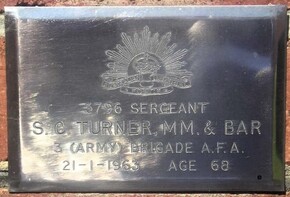TURNER, Stuart Chipman
| Service Number: | 3796 |
|---|---|
| Enlisted: | 1 December 1914 |
| Last Rank: | Sergeant |
| Last Unit: | 3rd Field Artillery Brigade |
| Born: | St Helens, Tasmania, Australia, 4 May 1894 |
| Home Town: | Glebe, Hobart, Tasmania |
| Schooling: | East Devonport State School, Tasmania, Australia |
| Occupation: | Postman |
| Died: | 21 January 1963, aged 68 years, cause of death not yet discovered, place of death not yet discovered |
| Cemetery: |
Cornelian Bay Cemetery and Crematorium, Tasmania |
| Memorials: | Hobart Postmaster-General's Department WW1 Honour Roll, Hobart Roll of Honour |
World War 1 Service
| 1 Dec 1914: | Enlisted AIF WW1, Gunner, 3796, 3rd Field Artillery Brigade | |
|---|---|---|
| 8 Apr 1915: | Involvement Gunner, 3796, 3rd Field Artillery Brigade , --- :embarkation_roll: roll_number: '3' embarkation_place: Brisbane embarkation_ship: HMAT Star of England embarkation_ship_number: A15 public_note: '' | |
| 8 Apr 1915: | Embarked Gunner, 3796, 3rd Field Artillery Brigade , HMAT Star of England, Brisbane | |
| 20 Jul 1918: | Promoted AIF WW1, Sergeant, 3rd Field Artillery Brigade |
Help us honour Stuart Chipman Turner's service by contributing information, stories, and images so that they can be preserved for future generations.
Add my storyBiography contributed by Stephen Brooks
Sergeant Stuart Chipman Turner was born in St Helens Tasmania. His parents were George Archibald and Mary Louisa Turner of Hobart, Tasmania. As a child, Turner joined the boy’s cadets formed by Mr. Frank Solomon at the State school, East Devonport. The day following the declaration of war he entered Fort Nelson, in Hobart to continue artillery training.
Enlisting in 1914, Turner served at the Anzac Landing with the 3rd Field Artillery Brigade until he was evacuated to Egypt sick with dysentery during August 1915.
He went to France with the First Division in April 1916. He was gassed twice, had two minor machine gun accidents and was slightly wounded in October, 1918, when clearing out a trench, but on no occasion had he been sent to England.
He was on four occasions recommended for gallantry and devotion to duty, eventually being awarded the Military Medal and Bar. Both awards involved him performing great deeds and showing great coolness in directing his gun and rescuing wounded men under very heavy bombardments on two separate occasions. He returned to Australia in January 1919 and was one of very few Australians who served at the Anzac Landing and served until the Armistice during November 1918.
His brother, George Archibald Turner also served with the 3rd Light Horse Regiment and returned to Australia.









